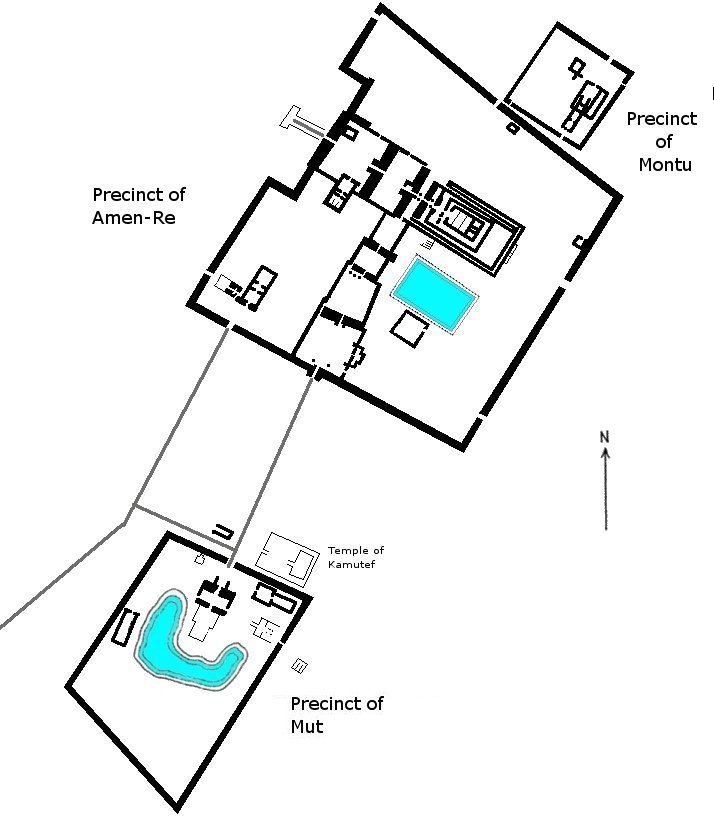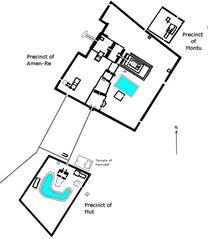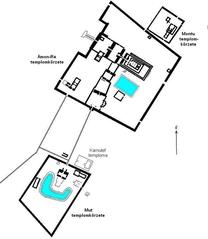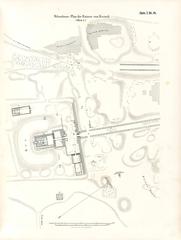
Precinct of Mut, Luxor, Egypt: Visiting Hours, Tickets, and Historical Insights
Date: 14/06/2025
Introduction
The Precinct of Mut, situated on the east bank of the Nile within the sprawling Karnak Temple Complex in Luxor, Egypt, stands as a remarkable testament to ancient Egyptian religious devotion and architectural achievement. Dedicated to Mut—the revered mother goddess of the Theban Triad—this temple complex offers visitors not only an immersive historical experience but also a tranquil alternative to the more frequented sections of Karnak. Home to a unique crescent-shaped sacred lake, hundreds of statues of the lioness goddess Sekhmet, and richly decorated temple ruins, the precinct reveals the spiritual, artistic, and political life of ancient Thebes. Whether you are a history enthusiast, a spiritual seeker, or a traveler eager to explore Luxor’s treasures, this comprehensive guide details the history, significance, visiting hours, ticket information, travel tips, and nearby attractions related to the Precinct of Mut (ARCE, ancient-egypt-online.com, Madain Project).
Table of Contents
- Overview and Historical Background
- Architectural Features and Layout
- Religious and Cultural Significance
- Archaeological Exploration and Restoration
- Practical Visitor Information
- FAQs
- Conclusion and Further Resources
Overview and Historical Background
The Precinct of Mut, one of four main temple precincts at Karnak, is dedicated to the goddess Mut, consort of Amun and mother of Khonsu, thus forming the Theban Triad (Wikipedia). Its origins trace back to the Middle Kingdom (c. 2055–1650 BCE), but it saw its greatest expansion during the New Kingdom under pharaohs like Hatshepsut, Thutmose III, and Amenhotep III (ARCE). Later additions were made by rulers such as Ramses III, Ramses IV, and Ramses XI, and the high priest-king Herihor completed major construction around 1085 BCE (Cairo Top Tours).
Mut’s precinct was a vital religious center and a focal point for rituals that reinforced royal legitimacy. Its sacred status is underscored by the absence of domestic or commercial structures within its boundaries throughout history (Arab America).
Architectural Features and Layout
Main Temple of Mut
At the heart of the precinct stands the Temple of Mut, notable for its pylon entrance, open courtyard filled with statues—primarily of Sekhmet—and an inner sanctuary. The temple’s hypostyle hall, constructed by Amenhotep III, features columns adorned with inscriptions and religious iconography.
Sacred Lake (Isheru)
A defining feature of the precinct is the crescent-shaped sacred lake known as the Isheru. Unique among Egyptian temples, this lake was central to purification rituals and festivals, symbolizing the primeval waters of creation (ancient-egypt-online.com). Priests’ houses discovered nearby indicate a resident priesthood responsible for daily offerings and the maintenance of the temple’s sanctity.
Subsidiary Temples and Chapels
Within the precinct are several smaller temples and chapels dedicated to deities such as Ramesses III, Hathor, and Ptah. The avenue of sphinxes, some ram-headed, connects the precinct with the main axis of Karnak and highlights the ceremonial interconnections among temple complexes.
Statues and Statuary
The precinct is renowned for its extensive collection of black granite statues of Sekhmet, the lioness goddess of war and healing. Amenhotep III is believed to have commissioned over 700 such statues, many of which remain in situ or have been restored (Madain Project). Their presence underscores the combined nurturing and protective forces associated with Mut and Sekhmet.
Religious and Cultural Significance
The Divine Role of Mut and the Theban Triad
Mut, whose name means “mother,” was the central goddess of the Theban Triad, alongside Amun and Khonsu. She was venerated as a creator, protector, and universal sovereign, often depicted with the double crown of Egypt or as a vulture, an animal sacred to her (ancient-egypt-online.com). The precinct was the heart of her cult, reinforcing her status in New Kingdom Thebes.
Rituals, Festivals, and Sacred Spaces
The precinct was the stage for elaborate rituals and processions, the most famous being the Opet Festival. During this annual event, statues of Amun, Mut, and Khonsu were carried in ceremonial boats from Karnak to Luxor Temple, symbolizing the king’s divine rejuvenation (ancient-egypt-online.com). The processional route, lined with criosphinxes (ram-headed sphinxes), emphasized the sacred connection between the temples.
Women and Priestesses
Mut’s status as a mother goddess made her precinct a center for female priesthoods. Women served as chantresses, musicians, and ritual specialists, playing a vital role in ceremonies and music offerings (egyptopia.com). This reflects the broader cultural respect for female divinity and the participation of women in Egyptian religious life.
Archaeological Exploration and Restoration
Archaeological interest in the Mut Precinct dates back to the Napoleonic expedition. Notable early excavations were led by Margaret Benson and Janet Gourlay in the late 19th century. In recent decades, restoration projects by institutions such as the Brooklyn Museum and Johns Hopkins University have stabilized the site and improved public access (Madain Project).
Practical Visitor Information
Visiting Hours
- Standard Hours: 6:00 AM to 5:00 PM daily.
- Seasonal Variations: Hours may be extended during peak tourist seasons or shortened for restoration work. Check locally or with your tour provider for updates.
Tickets and Entry
- Admission: Included in the general Karnak Temple Complex ticket. Special areas or events may require separate fees.
- Where to Buy: Tickets are available at the Karnak entrance or through authorized online vendors.
- Pricing: Rates differ for international tourists, locals, and students. Refer to official tourism websites for current prices.
Accessibility
- Terrain: The site features uneven ground and ancient pathways. Comfortable footwear is essential.
- Mobility: Some areas are not fully accessible to wheelchairs; guided tours can assist visitors with mobility challenges.
Guided Tours and Travel Tips
- Guided Tours: Strongly recommended for historical context and navigation. Egyptologists provide in-depth insights (Egyptian Streets).
- Best Times: Visit early morning or late afternoon for pleasant temperatures and optimal photography.
- Travel: The precinct is accessible by taxi, tuk-tuk, or on foot from the Karnak main entrance. Allow 15–20 minutes from Luxor city center.
Nearby Attractions
- Karnak Temple Complex: The main Amun-Re precinct with the iconic hypostyle hall.
- Luxor Temple: Located 1.5 miles south, connected by the avenue of sphinxes.
- Luxor Museum & Mummification Museum: Rich collections of artifacts and funerary exhibits.
- Valley of the Kings: West bank site with royal tombs, about 4 miles from Karnak.
Visitor Tips and Special Experiences
- Dress Code: Modest, breathable clothing, a hat, and sunscreen are recommended (Egyptian Streets).
- Hydration: Bring water; facilities can be limited.
- Photography: Allowed (without flash/tripod in many areas); check specific site rules.
- Cash: Carry small denominations for tips and purchases.
FAQs
Q: What are the opening hours of the Precinct of Mut?
A: Generally, 6:00 AM to 5:00 PM daily. Check for seasonal variations.
Q: Is a separate ticket required?
A: Admission is included with the general Karnak Temple Complex ticket. Some areas or events may require additional fees.
Q: How do I get to the Precinct of Mut?
A: By taxi, tuk-tuk, or on foot from Karnak’s main entrance. The precinct is located south of the Amun-Re temple.
Q: Is the precinct accessible for visitors with disabilities?
A: Some areas are uneven; limited accessibility. Guided tours can assist.
Q: Are guided tours available?
A: Yes, and they are highly recommended.
Q: What other attractions are nearby?
A: Karnak’s main precinct, Luxor Temple, Luxor Museum, and the Valley of the Kings.
Conclusion
The Precinct of Mut offers a unique journey into ancient Egyptian spirituality, art, and cultural heritage. As a serene and evocative part of the Karnak complex, it rewards visitors with its sacred lake, impressive statuary, and rich history of female divinity. Careful planning—regarding visiting hours, ticketing, and guided tours—ensures a rewarding experience. Exploring the precinct alongside other Luxor sites deepens your appreciation of Egypt’s ancient civilization. For current updates, visitor resources, and interactive guides, consider using the Audiala app and following official travel resources.
Further Reading and Reliable Sources
For more in-depth information, see:
- ARCE – Project: Mut Temple
- Ancient Egypt Online – Karnak Temple and Mut Precinct
- Madain Project – Karnak Temple Complex
- Sun Pyramids Tours Blog
- Nile Cruisez – Karnak Temple of Amun
- Cairo Top Tours – Temple of Mut
- Lonely Planet – Mut Temple Enclosure
- Arab America – Historical Significance of Karnak’s Temple
- Egyptian Streets – Tips for Visiting Egypt
- Egyptopia – Mut Temple in Luxor
- Mysteries Zone – Temple of Mut
- Earth Trekkers – Luxor Egypt Guide
For itinerary ideas and local travel tips:
Download the Audiala mobile app for offline maps, audio guides, and up-to-date information on Luxor historical sites. Follow us on social media for the latest archaeological news and visitor tips.

































































